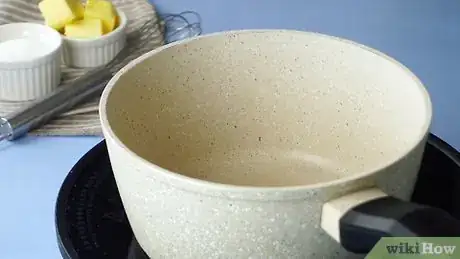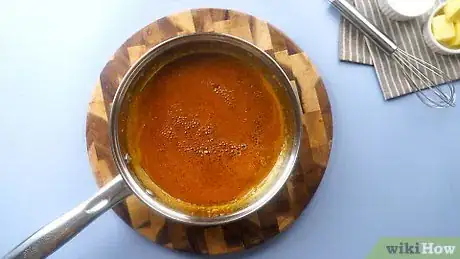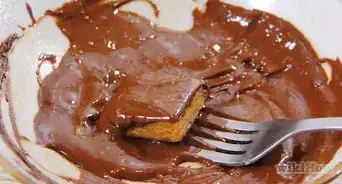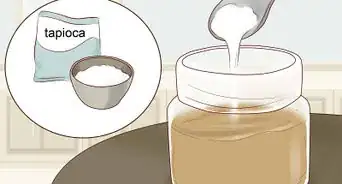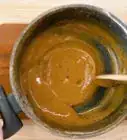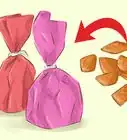This article was co-authored by Jessica Banh. Jessica Banh is a Pastry Chef and the Owner of Fancy Flavors in San Jose, California. With over 12 years of technical experience, Jessica has expertise in a wide variety of pastry techniques and has a focus on macarons. Her work has been featured in The SF Chronicle, The Mercury News, and Good Morning America. She received her training from The Professional Culinary Institute.
This article has been viewed 1,972,243 times.
Caramel is the result of melting and browning sugar. While perfecting caramel takes practice, sugar is cheap, so mistakes aren't costly. Choose between wet caramel (used for sauces and dipping apples) or dry caramel (firmer in consistency, it is made with melted sugar only and is used for making pralines, brittles and flans). Once you know what end purpose you need the caramel for, it's time to get started making your own caramel.
- Prep time: 10 minutes
- Cook time: 30 minutes
- Total time: 40 minutes
Ingredients
- 3/4 cup granulated sugar (you can also use white sugar)
- 1/4 cup water
- 1/2 cup heavy cream (optional)
- 1½ tablespoons unsalted butter
- 1 cup granulated sugar (you can also use white sugar)
Steps
Wet Caramel
-
1Prep your pot. You do not need any special equipment to make caramel, but the saucepan or skillet you use should be completely clean. Make sure the pot is heavy, solid, and light-colored so you can monitor the caramelization process. If you plan on adding cream to your caramel, be sure the pot you choose can accommodate the caramel's expansion.[1]
- Any impurities in your pot or on your cooking utensil (spoon, spatula) can cause an unwanted reaction called recrystallization. Recrystallization is a chemical process by which impurities and a compound (sugar) are dissolved in a solvent (water) and either the impurities or the compound can be coaxed out of the solution, leaving the other behind[2] . For our purposes, this means the formation of awful sugar clumps.
-
2Take safety precautions. Heated sugar can splatter, and burn you very badly. Wear long-sleeves, an apron, and an oven mitt. If you have glasses, wear them.
- Keep a deep bowl of cold water nearby to plunge your hand in if caramel lands on it.
Advertisement -
3Mix your sugar and water. Sprinkle the sugar in a thin layer at the bottom of your saucepan or skillet. Pour your water over the sugar slowly and evenly so all of the sugar is covered. Be sure there are no dry spots.
- Only use granulated sugar. Brown sugar and powdered sugars contain too many impurities and will not caramelize. Raw sugar is not recommended.
-
4Heat the sugar. Cook the sugar and water on medium heat until the sugar dissolves. Watch the mix closely and swirl the pot if you notice any sugar clumps forming. Most clumps will melt during cooking.
- To prohibit recrystallization, you can keep the pot covered until the sugar is completely melted. Any sugar crystals hanging on to the sides of the pot will be forced to the bottom by the condensation created.
- Another trick to prevent recrystallization is to add a tiny amount (a drop or two) of lemon juice or cream of tartar to the sugar water mix right at the moment it begins to dissolve. These recrystallization "agents" prevents large crystal lumps from forming by coating the smaller crystals.
- Some people also use a pastry brush dipped in water to wipe any sugar crystals off the sides of the pot during the heating process. While effective, the bristles can come off the brush and wind up in your beautiful caramel confection.
-
5Brown the sugar. Watch the sugar as it darkens. When it has reached the point of almost being burnt and when it is gently foaming and smoking, immediately remove it from the heat.
- Because cookware and stoves do not always distribute heat evenly, it is important that you stand over the caramel during the entire process. Browning occurs quickly and caramel can burn quickly if left unattended.[3]
-
6Cool it down. Add in the cream and butter to cool the pot and stop the cooking process.[4] Stir with a whisk on low heat. Any lumps that remain can be strained out. Cool the caramel and store in an airtight container.
- To make a salted caramel sauce, stir in 1/4 teaspoon of Kosher salt once the caramel mixture cools to room temperature.
- To make a vanilla caramel sauce, stir in 1 teaspoon of vanilla extract when you remove the caramel from the heat.
-
7Clean up. Cleaning up your sticky pan may seem daunting, but it is fairly simple. Either soak your pan in warm water or fill the pan with water and bring it to a boil. Boiling will melt all of the caramel.
Dry Caramel
-
1Put the sugar in a pan. Sprinkle an even layer of sugar in the bottom of a heavy skillet or saucepan. Be sure the pan is large enough to accommodate the sugar's expansion.
-
2Heat the sugar. Cook the sugar on medium heat. You will notice the edges of the sugar will begin to brown and cook first. With a clean heatproof utensil, push the liquefied sugar towards the middle of the pan.
- You want to make sure to move the liquefied sugar so it doesn't begin to burn. Once burnt, it cannot be saved.
- If lumps begin to form, turn down the heat slightly and stir slowly. The lumps should melt by the time you are done.[5]
-
3Brown the sugar. The process here will begin to speed up, so don't leave the stove. Watch as the sugar deepens in color to a rich amber. If a recipe you are using calls for the addition of a liquid (like cream), add it in now to cool the pan and slow the cooking process.
- Use caution when adding liquid to the pan as it will bubble up.
- If you are using the caramel in a mold (for flan or crème caramel) pour it into the mold now.
- To make pralines, add a cup of toasted, chopped nuts to the pan. Stir them slightly with a couple pinches of salt, and pour the mixture onto a wax-paper lined baking sheet to cool.[6]
-
4Cool it down. If you are not adding liquid to your caramel, another way to cool it down (and stop the cooking process) is to set the base of the pan in a large bowl of cold water. Clean the pan by soaking or boiling water in the pan until all of the caramel has melted away.
-
5Now you have your caramel sauce! Enjoy!
Expert Q&A
-
QuestionWhat is the trick to making caramel?
 Jessica BanhJessica Banh is a Pastry Chef and the Owner of Fancy Flavors in San Jose, California. With over 12 years of technical experience, Jessica has expertise in a wide variety of pastry techniques and has a focus on macarons. Her work has been featured in The SF Chronicle, The Mercury News, and Good Morning America. She received her training from The Professional Culinary Institute.
Jessica BanhJessica Banh is a Pastry Chef and the Owner of Fancy Flavors in San Jose, California. With over 12 years of technical experience, Jessica has expertise in a wide variety of pastry techniques and has a focus on macarons. Her work has been featured in The SF Chronicle, The Mercury News, and Good Morning America. She received her training from The Professional Culinary Institute.
Pastry Chef Use the caramel temperature as a guide! Cook your caramel until it's around 350 to 375 °F (177 to 191 °C). Once the sauce reaches 375 °F (191 °C), remove it from the heat and add in the other ingredients, like heavy cream and butter.
Use the caramel temperature as a guide! Cook your caramel until it's around 350 to 375 °F (177 to 191 °C). Once the sauce reaches 375 °F (191 °C), remove it from the heat and add in the other ingredients, like heavy cream and butter. -
QuestionCan I add vanilla?
 Community AnswerYes, but just be sure to add it in after you cooked it, or the vanilla flavor may evaporate. Take care when adding it in, as the vanilla might splatter for a couple of seconds.
Community AnswerYes, but just be sure to add it in after you cooked it, or the vanilla flavor may evaporate. Take care when adding it in, as the vanilla might splatter for a couple of seconds. -
QuestionHow long does it take until you know when it is finished?
 Community AnswerYou will know it's finished when it has started to bubble. Watch the caramel at all times as it is easy to burn it.
Community AnswerYou will know it's finished when it has started to bubble. Watch the caramel at all times as it is easy to burn it.
Warnings
- Any splashing will permanently damage glass cooking surfaces. Be careful about resting the stirring spoon on glass cooking surfaces.⧼thumbs_response⧽
- Non-stick coatings may be damaged by the high heat and could leach into the caramel.⧼thumbs_response⧽
- When cooking caramel, be sure to take safety precautions because hot sugar burns if it lands on skin.⧼thumbs_response⧽
- Tin-lined finishes can melt when cooking caramel.⧼thumbs_response⧽
Things You'll Need
- Pot
- Wooden spoon
- Candy thermometer
- Oven mitts or gloves
- Long sleeves
- Apron
- Eye protection (eyeglasses)
- Large bowl of ice water (optional)
References
- ↑ http://www.davidlebovitz.com/2008/01/ten-tips-for-ma-1/
- ↑ http://www.thefreedictionary.com/recrystallize
- ↑ http://www.theguardian.com/lifeandstyle/2011/nov/14/how-to-cook-caramel
- ↑ Jessica Banh. Pastry Chef. Expert Interview. 6 April 2022.
- ↑ http://www.davidlebovitz.com/2008/01/how-to-make-the/
- ↑ http://www.theguardian.com/lifeandstyle/2013/oct/19/kitchen-tips-how-to-make-caramel
About This Article
Before you make caramel, make sure your pot and utensils are completely clean, as any impurities can cause your sugar to recrystallize. Heat granulated sugar and water on medium heat until the sugar dissolves, swirling the pot if you notice any sugar clumps forming. When the sugar reaches the point of being almost burnt, and when it is gently foaming and smoking, immediately remove it from the heat. Add in the cream and butter to cool the pot and stop the cooking process. Stir with a whisk, then cool the caramel and store it in an airtight container. If you want to learn how to make dry caramel, keep reading the article!
